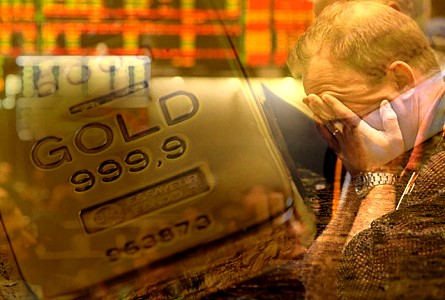By Louis Golino for CoinWeek …..
There are many different ways to try to explain and understand the precious metals markets.
Some people focus on short-term vs. long-term factors, while others stress underlying fundamentals. Profit-taking also often explains sudden drops like the one on Feb. 29, when gold plunged $70 in an hour.
There are also people who believe that these markets are subject to widespread manipulation by major banks that trade in metals.
All of those factors play a role, but sometimes markets simply act in ways that do not seem to be supported by the facts, at least at first glance.
 My point is not to try to predict short-term moves, but to attempt to understand underlying dynamics that investors should be aware of.
My point is not to try to predict short-term moves, but to attempt to understand underlying dynamics that investors should be aware of.
A closer examination of what happened shows that the drop actually made sense.
Gold dropped almost 5%, and silver plunged almost 8%, after having done very well so far this year. Until that day, gold was up almost 15% for the year, and silver’s gains were nearing 40% after a tough late 2011.
Monetary stimulus
Metal prices declined sharply because Federal Reserve Chairman Ben Bernanke made comments which were interpreted as decreasing the prospects for monetary stimulus in the U.S. But anyone paying attention knew that the short-term prospects for that were already very slim.
Meanwhile, the European Central Bank on the very same day actually did provide a second, major infusion of low-interest loans to European banks.
The ECB made another $710 billion available, which 800 European banks will be able to borrow at 1%. That is on top of a previous infusion last December of a similar amount, bringing the total to over 1 trillion euros, or almost $1.4 trillion.
One would think that the reality of stimulus in Europe, particularly when coupled with recent similar measures by the Bank of England, would have trumped the unrealistic expectation of further action by the U.S. Fed.
I think that Bernanke’s comments overshadowed the ECB action mainly because the U.S. still plays a larger role in shaping global economic developments than any other country or bloc.
In quick reactions to the day’s stunning developments, some metal analysts suggested that since the prospects for more QE were indeed not realistic, the plunge in prices was evidence of manipulation by the big banks.
I would not rule that out, but I would suggest that another explanation is that after the healthy run-up in prices this year, some profit-taking was in order.
Investors were disappointed that Federal Reserve chairman Ben Bernanke emphasized the recent improvement in the U..S. economy and downplayed the prospects for further monetary stimulus, or quantitative easing (QE).
Mr. Bernanke, in testimony to Congress, said that such actions would be conditional on the state of the economy, meaning that it would only be done if economic conditions deteriorate again.
But that was hardly news. He had already said as much in his previous statements in the past several months.
The Federal Reserve has come under intense scrutiny and criticism for its previous rounds of money supply expansion, even being accused of treason by former presidential candidate Rick Perry of TX.
There is a spirited debate between those who believe the economy is improving and those who see little evidence that things are getting better. On balance, the optimists are definitely in the majority right now, but multiple pressures remain.
Moreover, while I believe there have been some significant signs of improvement, the prospects for next year are clouded by the looming combination of tax increases and spending cuts, which would have a very deleterious impact on economic growth.
In addition, what matters is less how people say they feel about the economy, i.e., consumer confidence levels, and more how they actually act.
Europe looms
And, of course, Europe looms in the background.
In the short-term, the second EU bailout of Greece, the massive injection of liquidity into the European banking system by the European Central Bank, and the relatively mild European recession so far, probably mean there will not be a major crisis in the near future.
But numerous factors suggest that the twin European crisis of indebtedness and the banking system will be here for years to come.
Any combination of these factors could easily put the U.S. back into recession.
Ireland has just announced that it will put the new EU fiscal treaty to a referendum. Ireland has a history of rejecting EU measures when put to a public vote.
In addition, if French President Nicholas Sarkozy loses his bid for reelection this spring and is replaced by Socialist Francois Hollande, which polls suggest is very likely, France too will put the fiscal compact to a vote.
The compact requires euro-zone members to adhere to strict rules on government spending to help restore investor confidence.
Mr. Holland represents a view common among many people in Europe that there has been an excessive focus on austerity as a means of getting Europe out of its economic predicament. Higher economic growth, according to this view, is the only way out.
Underlying fundamentals
To understand where metals are headed over time one should return to fundamentals.
The key fundamentals are underlying economic conditions, the rate of inflation and its direction, supply and demand, and most importantly, interest rates.
In the past, many people believed that gold would not do well in an improving economy because in such an environment investors were likely to flock to other asset classes like stocks.
But today precious metals and the stock market typically move in the same direction. The main reason is that both are driven by interest rates and their impact on the risk environment.
Chairman Bernanke earlier this year took the unusual step of announcing that short-term interest rates, which are set by the Fed, would be held at close to zero until 2014. That has been a major catalyst for higher metal prices this year, and it is likely to continue doing so as the year progresses.
When nominal interest rates are so low that when coupled with inflation, savers are receiving a negative real rate of return, and the same is true of government bondholders, investors inevitably look for returns elsewhere.
This increases the appetite for riskier investments like stocks and metals.
Gold is typically described as an inflation hedge, but rising inflation will at some point result in higher interest rates, so oddly enough, gold may perform better in a low-inflation, low-interest-rate environment.
Finally, supply and demand factors should not be ignored.
Demand for precious metals remains very solid, especially in the physical market, and particularly in non-U.S. markets such as in Asia and other emerging markets.
And supply is likely to remain constrained. Higher commodity prices theoretically lead to increased supply, as the incentive for greater production increases.
But, as explained recently by articles in Mineweb [www.mineweb.com], it is not the spot price, but overall profit margins after input costs, that drive production. And input costs are rising because of the difficulty of finding new supplies, political upheaval in many of the countries where mining is concentrated, and other factors.
I would expect long-term metal investors to take advantage of the drop in spot prices, and over the course of the year, gold and other precious metals should resume their upward momentum.
 Louis Golino is a coin collector and numismatic writer, whose articles on coins have appeared in Coin World, Numismatic News, and a number of different coin web sites. His column for CoinWeek, “The Coin Analyst,” covers U.S. and world coins and precious metals. He collects U.S. and European coins and is a member of the ANA, PCGS, NGC, and CAC. He has also worked for the U.S. Library of Congress and has been a syndicated columnist and news analyst on international affairs for a wide variety of newspapers and web sites.
Louis Golino is a coin collector and numismatic writer, whose articles on coins have appeared in Coin World, Numismatic News, and a number of different coin web sites. His column for CoinWeek, “The Coin Analyst,” covers U.S. and world coins and precious metals. He collects U.S. and European coins and is a member of the ANA, PCGS, NGC, and CAC. He has also worked for the U.S. Library of Congress and has been a syndicated columnist and news analyst on international affairs for a wide variety of newspapers and web sites.





According to Mineweb, one large sell order for 31 tons of gold triggered yesterday’s plunge.
Great column, Louis. This ought to be run in major newspapers and not just on the internet!
One particular blogger I like to read, when we suffer these big drops, likes to speak to the fundamentals you mention in the last paragraph. I think sometimes both goldbugs and metals detractors get too caught up in the minutiae of day-to-day price movements rather than looking at the “big picture” as a whole.
On your note about about France, I am friends with someone who lives and works in France. In a recent email conversation with him, he said if Hollande won the election in April, S&P would have the country downgraded to BBB by May! Obviously he was joking somewhat, but it supports your concern about what a Hollande victory would mean.
Thanks so much for your comments and feedback, Captain. You are very kind.
I am a longtime student of France, and I look forward to following the election there this spring.
In today’s financial world many trades are triggered by computer models and the financial analysts talk about what happened when they shove a microphone in their faces. Most of the stuff they talk about is made up on the spot. The advice: never panic, study and know the markets on your own, follow your set goals and most importantly trust yourself.